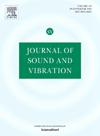Investigation on the dominant mechanism of chatter in high-load robot milling process based on theoretical and experimental analysis
IF 4.3
2区 工程技术
Q1 ACOUSTICS
引用次数: 0
Abstract
Chatter has always been a key problem restricting the improvement of robotic milling quality and efficiency. To avoid chatter, it is necessary to determine what is the dominant chatter mechanism (mode coupling or regenerative) of the robot milling system. Therefore, this paper focus on the dominant chatter mechanism in high-load (600kg) robot milling. The modal test results show that the dynamic flexibility of spindle-tool structure mode in high-load robot is significantly higher than that of the body structure mode, which is significantly different from the low-load robot in other studies. The mode coupling chatter stability prediction models are established based on eigenvalue method and zeroth order approximation, and the predicted stability boundaries are compared with the experimental results. The results show that only high-frequency chatter exists in the high speed region (1000–8000rpm), and no low frequency chatter occurs. The low-frequency chatter around the robot body mode is found in the low-speed region (400–1000rpm), but the mode coupling chatter theory could not explain the chatter varies periodically with the spindle speed. However, the stability boundary predicted by the regenerative chatter theory also changes periodically with the spindle speed. This indicates that the milling chatter dominant mechanism of high load robot is regenerative chatter. This study analyzes the milling chatter dominant mechanism of high-load robot through theoretical and experimental verification, which can provide theoretical support for high-load robot milling chatter control.
求助全文
约1分钟内获得全文
求助全文
来源期刊

Journal of Sound and Vibration
工程技术-工程:机械
CiteScore
9.10
自引率
10.60%
发文量
551
审稿时长
69 days
期刊介绍:
The Journal of Sound and Vibration (JSV) is an independent journal devoted to the prompt publication of original papers, both theoretical and experimental, that provide new information on any aspect of sound or vibration. There is an emphasis on fundamental work that has potential for practical application.
JSV was founded and operates on the premise that the subject of sound and vibration requires a journal that publishes papers of a high technical standard across the various subdisciplines, thus facilitating awareness of techniques and discoveries in one area that may be applicable in others.
 求助内容:
求助内容: 应助结果提醒方式:
应助结果提醒方式:


